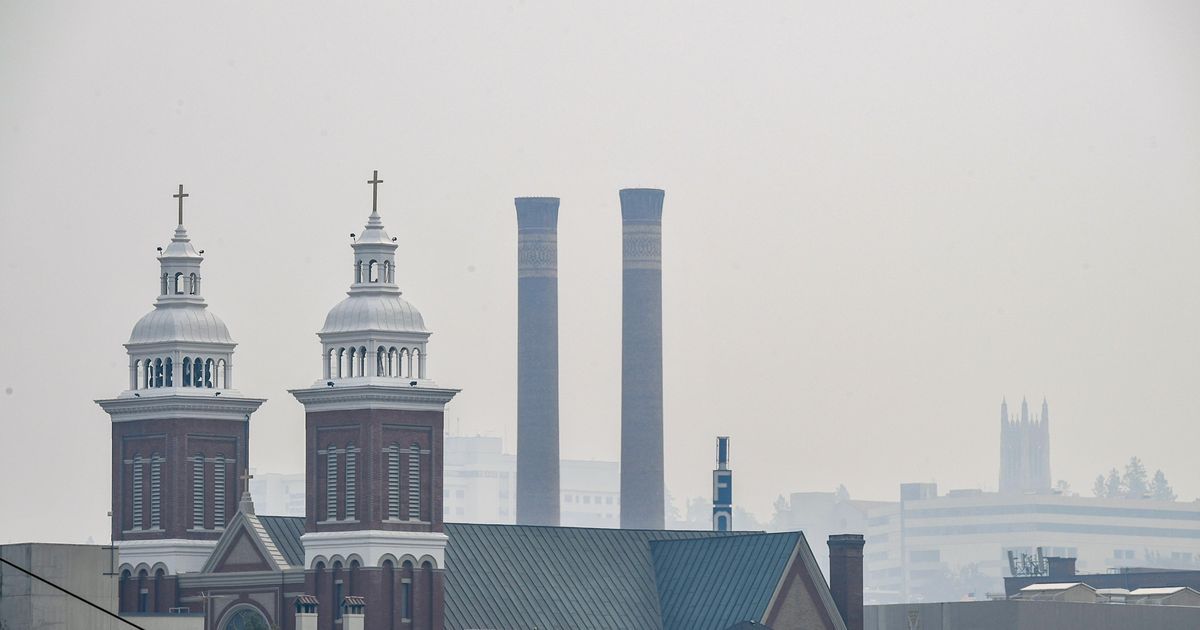New air quality sensors arrive in Spokane, part of state effort to combat pollution
New air quality sensors arrive in Spokane, part of state effort to combat pollution The Spokesman Review


Spokane County to Install Air Quality Sensors

Spokane County residents will soon have access to real-time information about air pollution in their neighborhoods. The Washington Department of Ecology is installing 11 new air quality sensors in Spokane and Spokane Valley as part of its efforts to strengthen the state’s air monitoring network.
SensWA Sensors Installed in Highly Impacted Areas
The SensWA sensors will be installed in 16 towns, cities, and communities, including Spokane, that have been identified as highly impacted by air pollution. These lightweight devices are specifically designed to measure the amount of PM2.5 (particulate matter smaller than 2.5 micrometers) in the air.
Importance of PM2.5 Monitoring
PM2.5 particles, which are smaller than a strand of hair, are commonly emitted by wood burning stoves, wildfires, and vehicle emissions. When inhaled, these particles can penetrate deep into the respiratory tract and even the bloodstream, causing both short- and long-term health problems. Chronic exposure to fine particle pollution can increase the risks of strokes, coronary heart disease, and death.
Vulnerability of Greater Spokane Area
A 2023 report highlighted the vulnerability of the greater Spokane area to air pollution due to high rates of poverty and unemployment, a lack of affordable housing, higher rates of asthma and chronic obstructive pulmonary disease, and lower life expectancy compared to other parts of the state.
Monitoring Locations
The sensors are strategically placed in areas that are overburdened and underprivileged, such as central Spokane, northeast Spokane, and the industrial area in northern Spokane Valley. Currently, four sensors are already operational in Spokane Valley at East Valley High School, Trent Elementary School, West Valley High School, and The Hive.
Utilizing Sensor Data
The data collected by the sensors will not only provide current air quality conditions but also enable two-day air quality forecasts, alerts for residents to take necessary measures, and identification of areas of concern. Additionally, the sensors will assist the state in evaluating the effectiveness of air pollution control strategies outlined in the Climate Commitment Act.
Funding and Future Steps
The funding for the sensors comes from the state’s carbon auctions, which will also be used for future efforts to combat pollution and improve air quality in these communities. The installation of sensors is phase one, followed by data collection and evaluation in phase two. The final step involves using the information to develop strategies and implement solutions. The Department of Ecology plans to launch a grant program later this year, with approximately $10 million available for individuals and organizations to develop solutions in their own communities.
Engaging with Communities
The Department of Ecology emphasizes community engagement throughout the process. They have organized town halls, tabling events, and a survey to gather input from the 16 identified towns and cities on how they have been affected by air pollution and what issues they would like to see addressed.
Immediate Impact for Spokane Area
The installation of sensors will provide hyperlocalized data for Spokane residents, allowing them to take necessary precautions when the air quality is unhealthy or hazardous. This information will help identify pollution hotspots within specific neighborhoods.
SDGs, Targets, and Indicators
-
SDG 3: Good Health and Well-being
- Target 3.9: By 2030, substantially reduce the number of deaths and illnesses from hazardous chemicals and air, water, and soil pollution and contamination.
- Indicator: PM2.5 levels in the air
-
SDG 11: Sustainable Cities and Communities
- Target 11.6: By 2030, reduce the adverse per capita environmental impact of cities, including by paying special attention to air quality and municipal and other waste management.
- Indicator: PM2.5 levels in the air
-
SDG 13: Climate Action
- Target 13.1: Strengthen resilience and adaptive capacity to climate-related hazards and natural disasters in all countries.
- Indicator: PM2.5 levels in the air
Table: SDGs, Targets, and Indicators
| SDGs | Targets | Indicators |
|---|---|---|
| SDG 3: Good Health and Well-being | Target 3.9: By 2030, substantially reduce the number of deaths and illnesses from hazardous chemicals and air, water, and soil pollution and contamination. | PM2.5 levels in the air |
| SDG 11: Sustainable Cities and Communities | Target 11.6: By 2030, reduce the adverse per capita environmental impact of cities, including by paying special attention to air quality and municipal and other waste management. | PM2.5 levels in the air |
| SDG 13: Climate Action | Target 13.1: Strengthen resilience and adaptive capacity to climate-related hazards and natural disasters in all countries. | PM2.5 levels in the air |
Analysis
The issues highlighted in the article are related to air pollution and its impact on public health, particularly in Spokane County. Based on the content of the article, the following SDGs, targets, and indicators can be identified:
1. SDG 3: Good Health and Well-being
This SDG is connected to the issues discussed in the article because it focuses on reducing deaths and illnesses caused by hazardous chemicals and air pollution.
Target 3.9: By 2030, substantially reduce the number of deaths and illnesses from hazardous chemicals and air, water, and soil pollution and contamination.
This target is relevant because it aims to reduce the adverse health effects of air pollution, which is a major concern in Spokane County.
Indicator: PM2.5 levels in the air
The article mentions that the air quality sensors installed in Spokane and Spokane Valley are designed to monitor fine particle pollution, specifically PM2.5 levels in the air. This indicator can be used to measure progress towards reducing the number of deaths and illnesses caused by air pollution.
2. SDG 11: Sustainable Cities and Communities
This SDG is addressed in the article because it focuses on improving the environmental impact of cities, including air quality management.
Target 11.6: By 2030, reduce the adverse per capita environmental impact of cities, including by paying special attention to air quality and municipal and other waste management.
This target is relevant because it emphasizes the need to reduce the negative environmental impact of cities, specifically by addressing air quality issues.
Indicator: PM2.5 levels in the air
The PM2.5 levels in the air can serve as an indicator to measure progress towards reducing the adverse per capita environmental impact of cities, particularly in terms of air quality management.
3. SDG 13: Climate Action
This SDG is connected to the issues discussed in the article because it focuses on strengthening resilience and adaptive capacity to climate-related hazards, including air pollution.
Target 13.1: Strengthen resilience and adaptive capacity to climate-related hazards and natural disasters in all countries.
This target is relevant because it emphasizes the need to build resilience and adaptability to climate-related hazards, including the impacts of air pollution on public health.
Indicator: PM2.5 levels in the air
The PM2.5 levels in the air can be used as an indicator to measure progress towards strengthening resilience and adaptive capacity to climate-related hazards, particularly in relation to air pollution.
Behold! This splendid article springs forth from the wellspring of knowledge, shaped by a wondrous proprietary AI technology that delved into a vast ocean of data, illuminating the path towards the Sustainable Development Goals. Remember that all rights are reserved by SDG Investors LLC, empowering us to champion progress together.
Source: spokesman.com

Join us, as fellow seekers of change, on a transformative journey at https://sdgtalks.ai/welcome, where you can become a member and actively contribute to shaping a brighter future.







